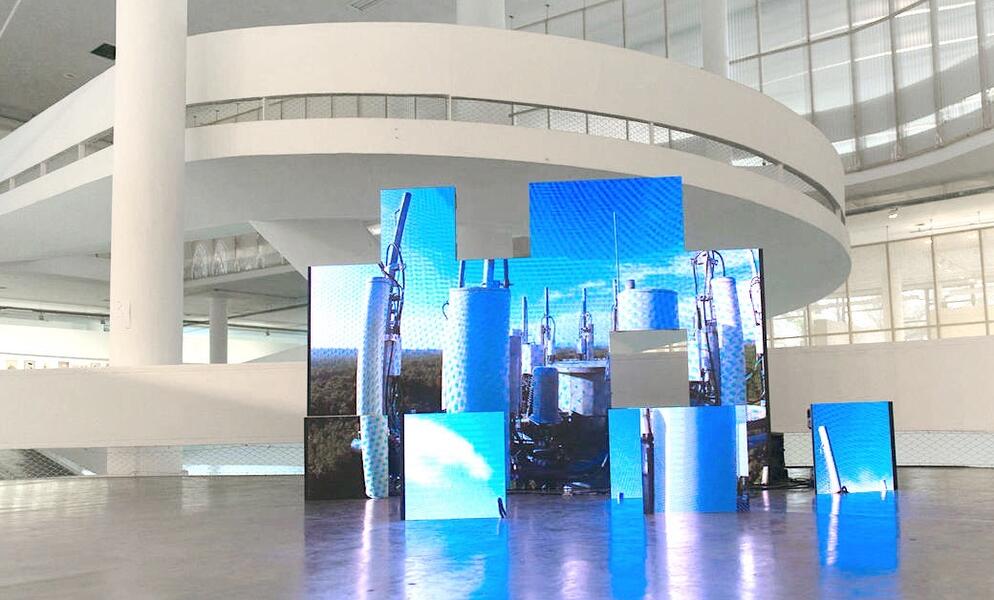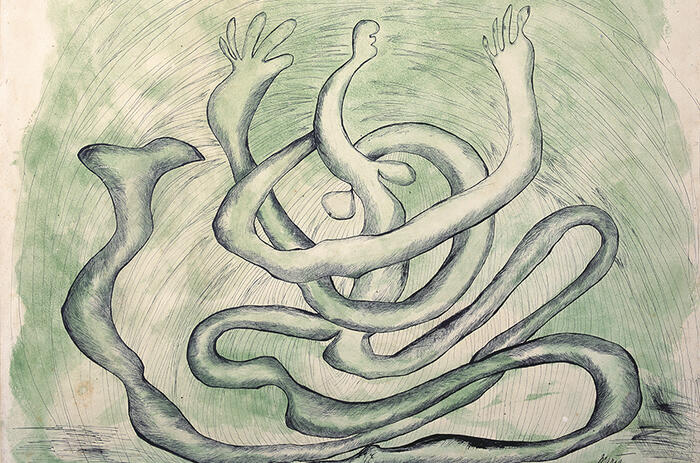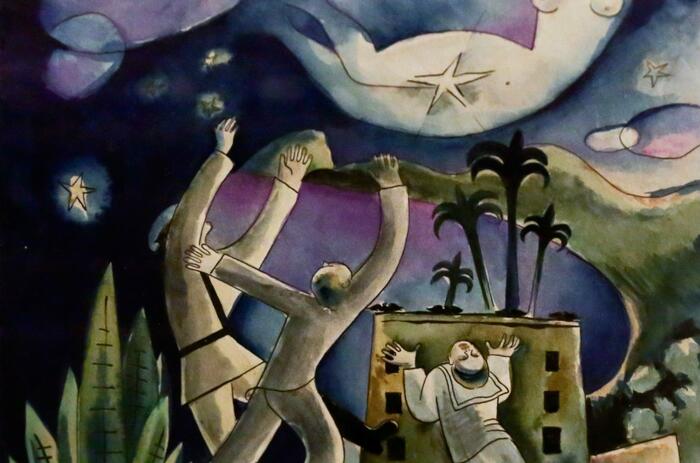SILENT RISINGS - 34th BIENNIAL OF SÃO PAULO, JURACI DÓREA AND GIORGIO MORANDI
One of the key works of the 34th São Paulo Biennial literally anchors the robust and uncomfortable presence between the interstitial areas of this modernist building, so questioned today. However, its meanings go beyond the perimeters of the construction and extend to, for example, some of the civic sculptures that populate public places throughout Brazil and that are also located in the surroundings.

Complexo Atlântico (Corda), by Arjan Martins, from Rio de Janeiro, consists of a heavy anchor located next to the central span of the pavilion designed by Oscar Niemeyer (1907-2012), which extends the support ropes on consecutive floors. If the visitor leaves the building towards the Obelisk, they can find the monument in honor of Admiral Tamandaré (1807-1897), patron of the Brazilian Navy. The bronze figure, together with the pedestal, is 11 m high from the viewer’s floor and has a massive anchor deposited to the left. The army has as some of its attributes the repression of the numerous rebel movements of the 19th century against the Portuguese empire and the leadership in Brazilian waters during the bloody Paraguayan War (1864-1870).
In the same park, then, the two three-dimensional works coexist. There is an installation with a strong critical tone against the complex networks of the slave trade of yesteryear, signed in 2021 by a prominent black artist in painting during a contemporary art exhibition shaken by themes from different areas, motifs and manifestations. And there is the monumental piece, placed in a generous public space, in an almost paradigmatic line in celebration of heroes of ancient conflicts with at least problematic results, and which has been demolished in the four corners of the globe.
Thus, in adverse and very particular conditions, Faz escuro mas eu canto -verse by Thiago de Mello, 95 year-old from the Amazon- condenses and is used by the curatorship led by the Italian based in Brazil Jacopo Crivelli Visconti as the main axis of one of the most important visual arts exhibitions in the world. The inauguration was delayed a year due to the pandemic and there were no few difficulties in rising and presenting this 34th edition of the event. And even with tours across the country and side exhibitions running through 2022, it can be said that the curatorial team was anything but bureaucratic.
The opposition between Arjan's current installation and the military monument from the past in question can provide a good starting point for the always multiple readings of the Biennale. It is also important to remember that the figure of João Cândido (1880-1969), leader of the Chibata Revolt (1910), precisely against the inhuman working conditions in the Navy, serves as a theme for the work of contemporary Paulo Nazareth and underlies one of the curatorial statements.
The generally fine connection between the approximately 1,000 works by 90 artists deserves proper attention. Nothing seems out of place, excessive, or shy. For those who know the modernist construction of Niemeyer, it is not little to say. And the parallel programming with extensive exhibitions by prominent artists, such as Alfredo Jaar and Antonio Dias (1944-2018), allowed to deepen and verticalize the investigations and approaches to the names seen in the Ibirapuera pavilion.
If only one work was chosen to represent such a court, the selection could fall on Por um novo baroque de vozes (Towards the New Baroque of Voices), a video by the Malian Manthia Diawara specially commissioned for this biennial. The audiovisual work acquires the contours of a video installation when it is placed in the old auditorium of the building, which was in disuse for many years and dates from 1954, with chairs and wooden floors, generating new friction in the 76-minute film essay by the filmmaker and poet now based in the United States. At the center of the production is the interview with Édouard Glissant (1928-2011), writer and thinker born in Martinique who talks about the right to opacity, also a relevant vector throughout the exhibition. A problem with the exhibition is allowing the sound of Ana Adamovic's video, contiguous in space, to invade the environment of Diawara's work and slightly break the complete reading of this audiovisual jewel.
Close to the Malian production, two surprising video installations by the Vietnamese artist Sung Tieu explore the artist's personal biography and the scars that have not yet been closed from the war that unfolded in the Asian country, in a seductive montage. Still in the same sector, the Wall Carpets by the Israeli Noa Eshkol (1924-2007), renowned named in her country’s dance world, evoke the collective spirit in difficult times (in this case, the Yom Kippur War, in 1973). Let us remember the solo show that the choreographer obtained in Casa do Povo, a former theater in the Jewish community in the historic neighborhood of Bom Retiro, in which the procedural and communal character was explored in videos and abundant documentation in notebooks, writings and books.
Indigenous art was well represented at this Biennial and one of the highlights of the exhibition is the presence of Daiara Tukano, with a beautiful series of works ranging from painting to pen art. The colorful series is flanked by the three-dimensional Amazonians, by the acclaimed Lygia Pape (1927-2004), who from the 1980s produced works between the experimental heritage of neo-concrete and the influence of native peoples, practically invisible in Río de Janeiro where the artist had always lived. In the same room visitors can see large-scale drawings by Joan Jonas -whose film Wind (1968) is central in the edition-, derived from performances, and sculptures of strong strangeness by the Chinese Guan Xiao, a very powerful duo. To bridge the gap, the union of pieces by Giorgio Morandi (1890-1964) and the lesser-known Christoforos Savvas (1924-1968) and Anna-Bella Papp create a set of previously unexplored relationships that reveal themselves as products of a refined articulation. Outside the theater, the destabilizing productions of Jaider Esbell (1979-2021) and Uýra bring an Amazon between the vernacular and the contemporary, the cosmogonic and the urban.
And the works of Daniel de Paula, Mauro Restiffe, Dirk Braeckman, Haris Epaminonda, Ximena Garrido-Lecca, Pia Arke, Victor Anicet, Zózimo Bulbul and Carmela Gross, among many others, deserve to be mentioned in an exhibition of such great breadth and established with more challenges than normally imposed
34th Bienal de São Paulo
Curatorship: Jacopo Crivelli Visconti, Paulo Miyada, Carla Zaccagnini, Francesco Stocchi and Ruth Estévez
Until December 5th, 2021
Ciccillo Matarazzo Pavilion, Ibirapuera Park
Beneath the mud of the earth - Juraci Dórea
In the extensive parallel program of the 34th São Paulo Biennial, a small clip located in the MuBE (Brazilian Museum of Sculpture and Ecology) dedicated to the production of the Bahian Juraci Dórea, now in his seventies, fascinates by renewing the interest in such a discreet author. For the 19th Biennial, in 1987, the artist exhibited drawings, photographs, three-dimensional designs, banners and sketches, among other elements, ranging from approaches to ecological art (the fundamental Projeto Terra, in process since 1982) to collective insertions with the population from the semi-arid region (as in Estandartes de Jacuípe, 1975). "We can think that Juraci's works are constructed as exercises to stay in place, as political insistence and poetic perseverance", highlights the exhibition's curator, Galciani Neves.
Debaixo do barro do chão - Juraci Dórea
Curatorship:Galciani Neves
Until January 16th, 2022
MuBE - Museo Brasileño de Escultura y Ecología
Morandi's legacy
Alberto Salvadori and Gianfranco Maraniello at the headquarters of the CCBB (Cultural Center of the Bank of Brazil) are curatorially working with 60 works, more than half by the artist born in Bologna and the rest with new perspectives on the corpus of work by a key painter of the modernity. There is a more than robust set of still lifes - engravings and landscapes are presented - but among all the varied creations one perceives "the silent reiteration, the parsimony, the simplicity", the curatorial team writes in the catalog. The not ostentatious permanence of Giorgio Morandi, therefore, as well as many of the essential elements of the 34th SP Biennial, may be more effective for the public than the more literal and noisy banners and invitations, as part of the media had perhaps complained before the exhibition took place.
O legado de Morandi
Curatorship:Alberto Salvadori e Gianfranco Maraniello
Until February 21st, 2022
CCBB-RJ / Banco de Brasil Cultural Center, Rio de Janeiro









